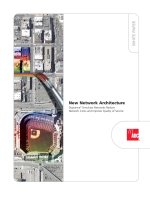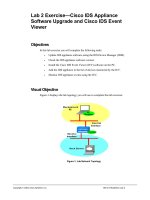Detecting And Mitigating Denial Of Service Attacks _ www.bit.ly/taiho123
Bạn đang xem bản rút gọn của tài liệu. Xem và tải ngay bản đầy đủ của tài liệu tại đây (13.68 MB, 120 trang )
Detecting and
Mitigating Denial of
Service Attacks
BRKSEC-214
Peter Provart
BRKSEC-2014
© 2006 Cisco Systems, Inc. All rights reserved.
Cisco Public
1
HOUSEKEEPING
We value your feedback, don’t forget to complete your online session
evaluations after each session and complete the Overall Conference
Evaluation which will be available online from Friday.
Visit the World of Solutions on Level -01!
Please remember this is a ‘No Smoking’ venue!
Please switch off your mobile phones!
Please remember to wear your badge at all times including the Party!
Do you have a question? Feel free to ask them during the Q&A section or
write your question on the Question form given to you and hand it to the
Room Monitor when you see them holding up the Q&A sign.
BRKSEC-2014
© 2006 Cisco Systems, Inc. All rights reserved.
Cisco Public
2
Objectives and Assumptions
How to detect and mitigate Denial of Services Attacks in a network.
Explaining what kind of threats which we need to defend against.
Explaining the various detection mechanisms which are available.
Explaining the different mitigation techniques, how they are used and the
possible consequences of implementing them.
The audience is assumed to consist of network architects, security officers
and project managers from SP and Large Enterprise customers.
Assumtion : The audience has a basic knowledge of routing protocols and
a good and broad understanding of various security techniques and tools
used in large networks today.
This session is related to sessions:
Network Core Infrastructure Protection: Best Practices (BRKSEC-2013)
Detecting Router Abuse (BRKSEC-2015)
Network-based Solutions for Broadband Residential Security (BRKSEC-2016)
The Techtorial Mitigating DoS Attacks (TECSEC-2003) also cover all those
techniques, so, if you attended the techtorial, there is no need to attend this
break-out session.
BRKSEC-2014
© 2006 Cisco Systems, Inc. All rights reserved.
Cisco Public
3
Agenda
Introduction : Threat Landscape
Six Phases of Incident Reaction process
Planning, Detection, Classification, Traceback, Reaction, Post
Mortem
Advanced Reaction Techniques
BRKSEC-2014
© 2006 Cisco Systems, Inc. All rights reserved.
Cisco Public
4
Introduction
Motivation and Trends
BRKSEC-2014
© 2006 Cisco Systems, Inc. All rights reserved.
Cisco Public
5
DDoS Attacks Are Here To Stay
DoS attacks grow from 119
to 1500 per day in 2005- an
increase of 1200%
Jan06-Jun06 : Avg 6110 Dos
Attacks per day an increase
of 600%
*Symantec Sept2006
Large % of DDoS attacks are
motivated by extortion
demands
50K Average Active Bots
Attack size is in the 2-7 Gig
range
Symantec Internet Security
Report – March ‘06
The DoS problem is not a
100 year flood anymore!
‘Zombie' ring allegedly hit 1.5 million computers
/>Dutch Internet provider XS4ALL identified the zombie network – “only a drop in the ocean."
BRKSEC-2014
© 2006 Cisco Systems, Inc. All rights reserved.
Cisco Public
6
Threat Economy: In the Past
Writers
Asset
End Value
Tool and
Toolkit Writers
Compromise
Individual
Host or
Application
Fame
Malware Writers
Worms
Compromise
Environment
Viruses
Theft
Espionage
(Corporate/
Government)
Trojans
BRKSEC-2014
© 2006 Cisco Systems, Inc. All rights reserved.
Cisco Public
7
Threat Economy: Today
Writers
First Stage
Abusers
Tool and
Toolkit Writers
Hacker/Direct
Attack
Middle Men
Second Stage
Abusers
Fame
Compromised
Host and
Application
Theft
Malware Writers
Worms
Machine
Harvesting
Bot-Net Creation
End Value
Extortionist/
DDoS-for-Hire
Espionage
(Corporate/
Government)
Extorted Pay-Offs
Viruses
Bot-Net Management:
Trojans
For Rent, for Lease,
for Sale
Spyware
Information
Harvesting
Personal
Information
Spammer
Commercial Sales
Phisher
Pharmer/DNS
Poisoning
Information
Brokerage
Identity Theft
Internal Theft:
Abuse of
Privilege
Fraudulent Sales
Click-Through
Revenue
Financial Fraud
Electronic IP
Leakage
$$$ Flow of Money $$$
BRKSEC-2014
© 2006 Cisco Systems, Inc. All rights reserved.
Cisco Public
8
Denial of Service Trends
Multipath
Truly distributed
DNS servers, large botnets
Reflective
Multivector
SYN AND UDP AND—
Use of non-TCP/UDP/ICMP protocols
Get past ACLs
Increased awareness in community
Target ISP Infrastructure
Target Applications
SMTP reflective, VoIP
BRKSEC-2014
© 2006 Cisco Systems, Inc. All rights reserved.
Cisco Public
9
Incident Response
How do you handle a DDOS attack?
BRKSEC-2014
© 2006 Cisco Systems, Inc. All rights reserved.
Cisco Public
10
Incident Response Methodology
for Worms and DoS
Imp
o
time critical
Preparation:
rtan
t!!
Best Practices / planning
Detection:
Something is wrong
Classification:
What is wrong
Traceback:
Find infection vector
Find ingress path
Reaction:
De-worming
Counter measures
Mbehring
- Contain
- ACLs upstream
- Quarantine - Re-direction
- Inoculate
Post Mortem
- SP trace back
Review
worm specific
DoS specific
common
BRKSEC-2014
© 2006 Cisco Systems, Inc. All rights reserved.
Cisco Public
11
Six Phases of Incident Response
Preparation
Post Mortem
What was done?
Can anything be done to
prevent it?
How can it be less
painful in the future?
Prep the Network
Create Tools
Test Tools
Prep Procedures
Train Team
Practice
Reaction
What options do you
have to remedy?
Which option is the
best under the
circumstances?
BRKSEC-2014
© 2006 Cisco Systems, Inc. All rights reserved.
Detection
How do you know
about the attack?
What tools can
you use?
What’s your process
for communication?
Classification
Traceback
What kind of
attack is it?
Where is the attack coming
from?
Where and how is it
affecting the network?
What other current
network problems are
related?
Cisco Public
12
Preparation
Preparation—Develop and Deploy a Solid
Security Foundation
Includes technical and non-technical components
Encompasses best practices
The hardest yet most important phase
Without adequate preparation, you are
destined to fail
The midst of a large attack is not the time to be
implementing foundational best practices and
processes
BRKSEC-2014
© 2006 Cisco Systems, Inc. All rights reserved.
Cisco Public
13
Preparation
Know the enemy
Understand what drives the miscreants
Understand their techniques
Create the security team and plan
Who handles security during an event; is it the security folks; the
networking folks
A good operational security professional needs to be a cross
between the two: silos are useless
Harden the devices
Prepare the tools
Network telemetry
Reaction tools
BRKSEC-2014
© 2006 Cisco Systems, Inc. All rights reserved.
Cisco Public
14
Detection
Detection —How Do You Know You or
Your Customer Is Under Attack?
It is more than just waiting for your customers to
scream or your network to crash
What tools are available?
What can you do today on a tight budget?
BRKSEC-2014
© 2006 Cisco Systems, Inc. All rights reserved.
Cisco Public
15
Detection —Ways to Detect
Customer call
“The Internet is down”
Unexplained changes in network baseline
SNMP: line/CPU overload, drops
Bandwidth
NetFlow
BRKSEC-2014
ACLs with logging
Backscatter
Packet capture
Network IDS
Anomaly detection
© 2006 Cisco Systems, Inc. All rights reserved.
Cisco Public
16
Detection —Network Baselines
NMS baselines
Unexplained changes in link utilization
Worms can generate a lot of traffic, sudden changes
in link utilization can indicate a worm
Unexplained changes in CPU utilization
Worm scans can affect routers/switches resulting in increased
CPU both process and interrupt switched
Unexplained syslog entries
These are examples
Changes don’t always indicate a security event
Must know what’s normal in order to identify
abnormal behavior
BRKSEC-2014
© 2006 Cisco Systems, Inc. All rights reserved.
Cisco Public
17
Classification
Classification—understand the details and
scope of the attack
Identification is not sufficient; once an attack
is identified, details matter
Guides subsequent actions
Identification and classification are often simultaneous
BRKSEC-2014
© 2006 Cisco Systems, Inc. All rights reserved.
Cisco Public
18
Classification
Qualify and quantify the attack without jeopardizing
services availability (e.g., crashing a router):
What type of attack has been identified?
What’s the effect of the attack on the victim(s)?
What next steps are required (if any)?
At the very least:
Source and destination address
Protocol information
Port information
BRKSEC-2014
© 2006 Cisco Systems, Inc. All rights reserved.
Cisco Public
19
Traceback
Traceback—what are the sources of the attack?
How to trace to network ingress points
Your Internet connection is not the only vector
Understand your topology
Traceback to network perimeter
NetFlow
Backscatter
Packet accounting
Retain attack data
Use to correlate interdomain traceback
Required for prosecution
Deters future attacks
Clarify billing and other disputes
Post mortem analysis
BRKSEC-2014
© 2006 Cisco Systems, Inc. All rights reserved.
Cisco Public
20
Reaction
Reaction—Do Something to Counter the Attack
Should you mitigate the attack?
Where? How?
No reaction is a valid form of reaction in certain
circumstances
Reaction often entails more than just throwing an ACL
onto a router
BRKSEC-2014
© 2006 Cisco Systems, Inc. All rights reserved.
Cisco Public
21
Post Mortem
Post Mortem—Analyze the Event
The step everyone forgets
What worked? What didn’t? How can we improve?
Protect against repeat occurrences?
Was the DoS attack you handled the real threat?
Or was it a smoke screen for something else that just
happened?
What can you do to make it faster, easier, less painful
in the future?
Metrics are important
Resources, headcount, etc.
BRKSEC-2014
© 2006 Cisco Systems, Inc. All rights reserved.
Cisco Public
22
Preparation and
Detection
Preparing your infrastructure and systems to detect and react to
DDOS attacks.
BRKSEC-2014
© 2006 Cisco Systems, Inc. All rights reserved.
Cisco Public
23
Preparation
Visibility of Infrastructure traffic
Creation of Reaction mechanisms
Procedures to follow during attack.
Rehearsal of DDOS attack
Reporting and Post Mortem process’s
BRKSEC-2014
© 2006 Cisco Systems, Inc. All rights reserved.
Cisco Public
24
Visibility via Network Telemetry
SNMP
NetFlow
RMON
BGP
Syslog
Packet capture
Others
BRKSEC-2014
© 2006 Cisco Systems, Inc. All rights reserved.
Cisco Public
25









